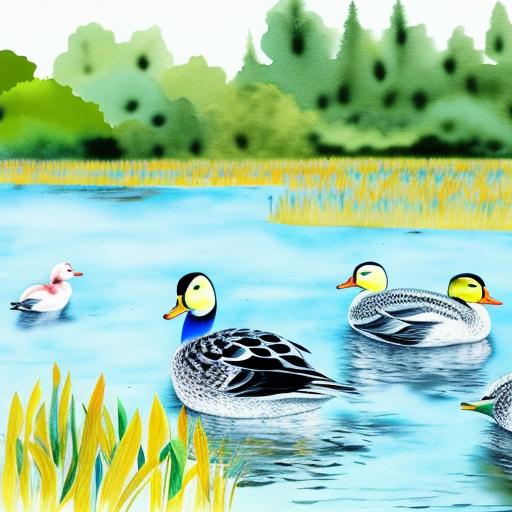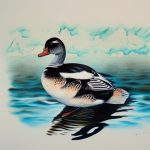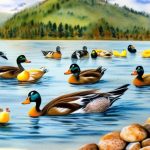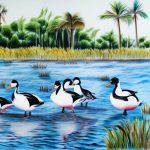The 2018 spring breeding duck population has been a topic of great interest and concern for wildlife enthusiasts, conservationists, and hunters alike. The spring breeding duck population is a crucial indicator of the health and sustainability of duck species, as it directly impacts the availability of ducks for hunting and the overall ecological balance of wetland ecosystems. The annual spring breeding duck population survey, conducted by the U.S. Fish and Wildlife Service, provides valuable data on the abundance and distribution of various duck species across North America. This information is essential for informing conservation efforts, setting hunting regulations, and understanding the overall health of duck populations.
The 2018 spring breeding duck population survey revealed both positive and concerning trends. Overall, the survey estimated a total population of 41.2 million breeding ducks in the traditional survey area, which is 13 percent lower than the 2017 estimate of 47.3 million, but still 17 percent above the long-term average. While this decline is notable, it is important to consider the various factors that may have influenced this year’s population numbers. Understanding these factors is crucial for interpreting the survey results and implementing effective conservation measures to support duck populations.
Key Takeaways
- The 2018 spring breeding duck population saw an increase in numbers compared to previous years.
- Factors influencing the 2018 spring breeding duck population include weather conditions, habitat loss, and hunting pressure.
- The geographic distribution of the 2018 spring breeding duck population varied across different regions, with some areas experiencing higher concentrations of ducks.
- Conservation efforts for the 2018 spring breeding duck population focused on habitat restoration, hunting regulations, and public awareness campaigns.
- The 2018 spring breeding duck population has implications for hunters and wildlife enthusiasts, as it may impact hunting opportunities and bird-watching experiences.
- The 2018 spring breeding duck population is compared to previous years to assess trends and changes in duck populations over time.
- The future outlook for the 2018 spring breeding duck population depends on continued conservation efforts and the impact of environmental factors on duck populations.
Factors influencing the 2018 spring breeding duck population
Several factors have contributed to the fluctuations in the 2018 spring breeding duck population. One significant factor is the variation in weather patterns and habitat conditions across different regions. The spring breeding duck population is heavily influenced by the availability of suitable nesting and brood-rearing habitats, which are directly impacted by precipitation, temperature, and water levels. In 2018, some areas experienced unfavorable weather conditions, such as drought or late spring snowstorms, which can negatively affect nesting success and chick survival rates. These adverse weather events can lead to reduced breeding success and ultimately lower population numbers for certain duck species.
Another factor influencing the 2018 spring breeding duck population is habitat loss and degradation. Wetland habitats are essential for ducks during the breeding season, providing critical resources for nesting, feeding, and rearing young. However, ongoing habitat loss due to urban development, agriculture expansion, and other human activities has significantly reduced the availability of suitable breeding habitats for ducks. Additionally, degradation of existing wetlands through pollution, invasive species, and habitat fragmentation further compounds the challenges faced by breeding duck populations. These habitat-related factors have direct implications for the success and sustainability of duck populations, making habitat conservation a top priority for ensuring healthy breeding populations.
Geographic distribution of the 2018 spring breeding duck population
The 2018 spring breeding duck population survey provides valuable insights into the geographic distribution of various duck species across North America. The survey covers a vast area, including traditional breeding grounds in the Prairie Pothole Region, boreal forests, and other key habitats in the United States and Canada. This comprehensive assessment allows researchers to identify regional variations in duck populations and assess the overall health of breeding populations in different areas.
The Prairie Pothole Region, often referred to as the “duck factory” due to its importance for waterfowl production, is a focal point of the spring breeding duck population survey. This region encompasses parts of North Dakota, South Dakota, Minnesota, and Montana, as well as portions of Canada. It provides critical nesting habitat for numerous duck species, including mallards, pintails, gadwalls, and blue-winged teal. The survey results indicate that this region continues to be a vital breeding area for ducks, despite some fluctuations in population numbers.
In addition to the Prairie Pothole Region, the survey also assesses duck populations in other key habitats, such as the boreal forests of Canada and the Great Lakes region. These areas support a diverse array of duck species and play a crucial role in maintaining healthy breeding populations. By analyzing the geographic distribution of the 2018 spring breeding duck population, conservationists can prioritize conservation efforts in areas with declining populations and work to protect critical habitats for ducks across their range.
Conservation efforts for the 2018 spring breeding duck population
Conservation efforts for the 2018 spring breeding duck population are essential for ensuring the long-term sustainability of duck species and their habitats. The decline in breeding duck populations in certain areas highlights the urgency of implementing effective conservation measures to address key threats and challenges facing ducks. One of the primary conservation strategies is habitat protection and restoration. Preserving existing wetlands and restoring degraded habitats are critical for providing ducks with suitable nesting and brood-rearing areas. Conservation organizations and government agencies work to acquire and protect important wetland habitats through land conservation programs and easements.
In addition to habitat conservation, predator management is another important aspect of duck population conservation. Predation can significantly impact nesting success and chick survival rates for ducks. Implementing predator control measures in key nesting areas can help reduce predation pressure on breeding ducks and improve their reproductive success. This may involve targeted predator removal or habitat management to create safer nesting environments for ducks.
Furthermore, public awareness and education play a crucial role in supporting conservation efforts for the 2018 spring breeding duck population. Engaging with local communities, landowners, and stakeholders to raise awareness about the importance of wetland conservation and responsible land management can help garner support for conservation initiatives. By fostering a sense of stewardship for wetland habitats and wildlife, conservation organizations can mobilize collective action to protect breeding duck populations for future generations.
Implications of the 2018 spring breeding duck population for hunters and wildlife enthusiasts
The 2018 spring breeding duck population has important implications for both hunters and wildlife enthusiasts. For hunters, the abundance and distribution of breeding ducks directly impact hunting opportunities and regulations. The decline in certain duck populations may result in more restrictive hunting seasons or bag limits to ensure sustainable harvest levels. Conversely, healthy breeding populations can lead to increased hunting opportunities for waterfowl enthusiasts.
Wildlife enthusiasts also have a vested interest in the spring breeding duck population, as it reflects the overall health of wetland ecosystems and biodiversity. Ducks are integral components of wetland food webs and play a vital role in maintaining ecological balance. A decline in breeding duck populations can signal broader environmental issues affecting wetland habitats and other wildlife species that depend on these ecosystems.
Moreover, the 2018 spring breeding duck population serves as a barometer for assessing the effectiveness of conservation efforts and habitat management practices. By monitoring changes in duck populations over time, researchers can evaluate the impact of conservation initiatives and adapt management strategies to better support breeding ducks. This information is valuable for guiding future conservation actions and ensuring that wetland habitats remain viable for ducks and other wildlife.
Comparison of the 2018 spring breeding duck population with previous years

Comparing the 2018 spring breeding duck population with previous years provides valuable insights into long-term population trends and helps identify potential challenges facing duck species. Over time, researchers have observed fluctuations in breeding duck populations due to various environmental factors, habitat changes, and human activities. By analyzing historical data alongside the 2018 survey results, scientists can gain a better understanding of how duck populations have responded to these influences.
In comparison to previous years, the 2018 spring breeding duck population exhibited a decline from the 2017 estimate but remained above the long-term average. This decline may be attributed to specific regional factors such as adverse weather conditions or habitat loss in key nesting areas. Understanding these variations is crucial for identifying areas of concern and implementing targeted conservation measures to address underlying threats to breeding ducks.
Furthermore, comparing the 2018 spring breeding duck population with historical data allows researchers to assess population trends for individual duck species. Some species may show stable or increasing populations over time, while others may exhibit declines or fluctuations. By examining these trends, conservationists can prioritize conservation efforts for species that are facing significant challenges and work to address specific threats affecting their breeding success.
Future outlook for the 2018 spring breeding duck population
The future outlook for the 2018 spring breeding duck population hinges on continued conservation efforts, adaptive management strategies, and addressing key threats to duck habitats. While fluctuations in population numbers are expected due to natural variability and environmental factors, proactive conservation measures can help mitigate these challenges and support healthy breeding populations.
Looking ahead, it will be essential to monitor how breeding duck populations respond to ongoing habitat conservation initiatives, predator management efforts, and climate-related changes. By tracking population trends over time, researchers can assess the effectiveness of these interventions and make informed decisions about adjusting management strategies as needed.
Additionally, collaboration among government agencies, conservation organizations, landowners, and stakeholders will be critical for ensuring a sustainable future for breeding ducks. By working together to protect and restore wetland habitats, manage predator impacts, and raise public awareness about the importance of wetland conservation, we can help secure healthy breeding populations for generations to come.
In conclusion, the 2018 spring breeding duck population serves as a vital indicator of the health and sustainability of duck species across North America. By understanding the factors influencing population fluctuations, prioritizing habitat conservation efforts, and engaging with hunters and wildlife enthusiasts, we can work towards supporting thriving breeding duck populations and preserving essential wetland ecosystems. With continued dedication to conservation and adaptive management practices, we can help ensure a bright future for North America’s diverse array of breeding ducks.
The 2018 spring breeding duck population has been a topic of interest for many poultry enthusiasts. If you’re interested in learning more about breeding and raising poultry, you might find the article on “when do guinea fowl lay eggs” from Poultry Wizard particularly informative. This article provides valuable insights into the breeding habits of guinea fowl, offering practical tips for poultry breeders. Check it out here.
FAQs
What is the 2018 spring breeding duck population?
The 2018 spring breeding duck population refers to the estimated number of breeding ducks in North America during the spring of 2018.
How is the 2018 spring breeding duck population estimated?
The 2018 spring breeding duck population is estimated through aerial surveys conducted by wildlife agencies and organizations across North America. These surveys cover key breeding areas and provide data on duck abundance and distribution.
Why is the 2018 spring breeding duck population important?
The 2018 spring breeding duck population is important for wildlife management and conservation efforts. It helps wildlife agencies and organizations monitor the health of duck populations, assess the effectiveness of conservation measures, and make informed decisions about hunting regulations and habitat protection.
What are the key findings of the 2018 spring breeding duck population survey?
The key findings of the 2018 spring breeding duck population survey include estimates of total duck abundance, species-specific population trends, and comparisons to previous years’ surveys. These findings provide valuable insights into the status of duck populations and inform conservation strategies.
How does the 2018 spring breeding duck population compare to previous years?
The 2018 spring breeding duck population may be compared to previous years’ surveys to assess population trends and changes over time. This comparison helps identify potential threats to duck populations and evaluate the effectiveness of conservation efforts.
Meet Walter, the feathered-friend fanatic of Florida! Nestled in the sunshine state, Walter struts through life with his feathered companions, clucking his way to happiness. With a coop that’s fancier than a five-star hotel, he’s the Don Juan of the chicken world. When he’s not teaching his hens to do the cha-cha, you’ll find him in a heated debate with his prized rooster, Sir Clucks-a-Lot. Walter’s poultry passion is no yolk; he’s the sunny-side-up guy you never knew you needed in your flock of friends!







